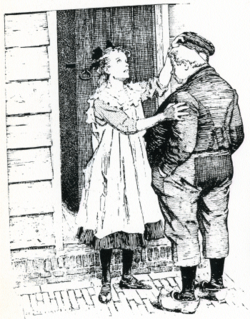Social:Girl next door

The girl next door is a young female stock character who is often used in romantic stories. She is so named because she often lives next door to the protagonist or is a childhood friend. They start out with a mutual friendship that later often develops into romantic attraction.
A similar expression is "boy next door".
Characteristics
A "girl next door" character is often seen as natural and unpretentious. A trope that evokes nostalgia, it is associated with small towns and more local or even rural ways of life.[1] The girl next door is often portrayed as innocent.[1]
Doris Day of the 1950s is described as a pioneering embodiment of the "girl next door" image in film,[1] the "Hollywood's girl next door".[2]
A common cliche is when a male protagonist is caught in a love triangle between two women, he will usually choose the "sweet, ordinary, and caring girl next door" he grew up with rather than a more well-off or beautiful woman with fewer morals.[3] Other times, this character ignores the hero for another male character, despite being the object of his affections.[4][better source needed]
The character Mary Ann Summers from the TV show Gilligan's Island (portrayed by Dawn Wells) had the girl next door allure, in a contrast with the more glamorous character Ginger Grant (portrayed by Tina Louise).[5] Due to the popularity of the show and the two lead female characters, the question "Ginger or Mary Ann?" became shorthand for asking someone whether they preferred a girl next door type or a more glamorous type.[6]
See also
- Farmer's daughter
- Friend zone
- Innamorati
References
- ↑ 1.0 1.1 1.2 McDonald, Tamar Jeffers (2013-09-27). Doris Day Confidential: Hollywood, Sex and Stardom. London. pp. 77-86. ISBN 978-0857722799. OCLC 862101452.
- ↑ "Actress And Singer Doris Day, Hollywood's Girl Next Door, Dies At 97"
- ↑ Ebert's bigger little movie glossary : a greatly expanded and much improved compendium of movie clichés, stereotypes, obligatory scenes, hackneyed formulas, shopworn conventions, and outdated archetypes. Ebert, Roger.. Kansas City, Mo.: Andrews McMeel. 1999. ISBN 0740792466. OCLC 829154479.
- ↑ Romancing the zombie : essays on the undead as significant "other". Szanter, Ashley,, Richards, Jessica K.,, Bishop, Kyle William, 1973-. Jefferson, North Carolina. 2017-08-14. pp. 45. ISBN 978-1476667423. OCLC 987796701.
- ↑ Erskine, Chris (August 22, 2019). "I invited Mary Ann to a Gilligan-themed tiki party — and she showed up". Los Angeles Times. https://www.latimes.com/lifestyle/story/2019-08-21/i-invited-mary-ann-to-a-gilligan-themed-tiki-party-and-she-accepted.
- ↑ Fashingbauer Cooper, Gael (September 17, 2014). "Ginger or Mary Ann? 'Gilligan' fans still ponder question". Today. https://www.today.com/popculture/ginger-or-mary-ann-gilligan-fans-still-ponder-question-1D80149264.
Further reading
- Levine, Michal P.; Schneider, Steven Jay (2003). "Feeling for Buffy: The Girl Next Door". in South, James B.. Buffy the Vampire Slayer and Philosophy: Fear and Trembling in Sunnydale. Open Court. pp. 294–308. ISBN 978-0-8126-9531-1. https://books.google.com/books?id=dx_n2IDCJqUC&q=%22Feeling+for+Buffy%3A+The+Girl+Next+Door.%22&pg=PA294.
- From a review: "To Michal Levine and Steven Jay Schneider ... Buffy is just another unconscious Freudian reality tale starring the proverbial girl next door." in: Joss Whedon: The Complete Companion: The TV Series, the Movies, the Comic Books, and More
- Frank, Rich (February 20, 1994). "Journal: The Girl Next Door". The New York Times. https://www.nytimes.com/1994/02/20/opinion/journal-the-girl-next-door.html.
- The article criticizes Sports Illustrated for their misuse of term "girl next door": "Otherwise the magazine is still pushing what Ms. Brinkley repeatedly described as the "natural beauty" of "what readers long for – the girl next door". Who is the girl next door? Her fake name keeps changing but she is still the same empty-headed, smiling, air-brushed mannequin who appeared in Playboy in the 1950s and early 60s..."
 |
